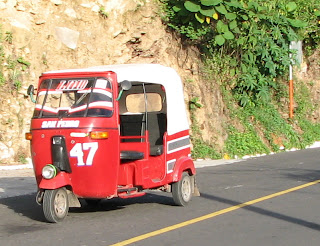The bus wasn’t very crowded. And only a few black plastic bags were tucked onto the shelves above, as well as a few knapsacks. Our bags were too large to put on the shelves, so we each took our own seat, uncertain as to how we might crowd both our backpacks and the two of us onto one seat, and as of yet, there was no need. Though the bus had appeared ready to leave, the progress from bus port to street was painstakingly slow. As the bus inched forward and stopped, inched forward and stopped, in popped a beggar asking for handouts. Then a man with fireman’s hat and coat entered, made a speech, collected a few Quetzals as he made his way through, and exited at the rear of the bus. More passengers began to hop on as the bus worked its way to the street.
Sugata motioned for me to join him, and after arranging our backpacks a couple of times, we managed to squeeze everything onto one seat. Really, what excuse had we? A family of four would later sit two seats in front of us.
Just then, a discreet foreigner popped into the bus and took the seat which I had so recently evacuated. She tightened her tiny ponytail and in a moment was flipping through a stack of 3X5 cards. “She’s studying Spanish,” I whisper to Sugata. “Talk to her,” he says. I hesitate as I peer over her shoulder at the cards she’s holding.
The driver turns on some lively music and the bus ride begins to feel like a festive occasion. When I look up I realized that not only do we have audio, but video, complete with men who look like they think they’re oh-so- cool, and women shaking their scarcely-clad “stuff.” A stuffed toy monkey clings to the side of the screen. His companions, a small white bear and a brown bear, sit next to him, each holding a red velvet heart. From the driver’s mirror dangles a CD painted with the figure of the Virgin Mary. It swings back and forth as the bus jolts along.
After a good long while of alternating my gaze between music video and passing scenery, we are out of town. The driver takes us into the curves, full speed ahead. It is then that I remember what riding a chicken bus is all about, that not only will I listen to festive music, but I’ll be taking roller coaster ride without the benefit of security straps. I grab onto the bar in front of me with both hands and hang on. Lucky me, I have the aisle seat. By the time this bus journey is over, I will feel like I’ve been to one of the more strenuous Cross-fit workouts.
It’s surprising that such a bus, packed with so many people, can fly up these turns so fast. It’s also surprising that quite a lot of the natives on the bus can nap or eat quite comfortably under such conditions. Occasionally the bus stops to pick up more people, and I can, in those moments unclench my hand. It is in one of these lulls when I finally tap the foreigner on the shoulder.
Three buses later we are in Panahachel.

